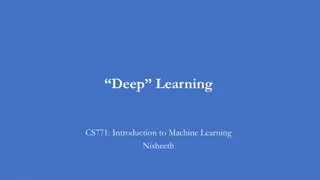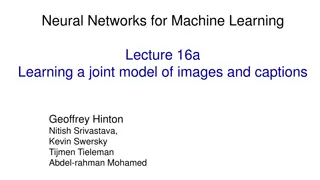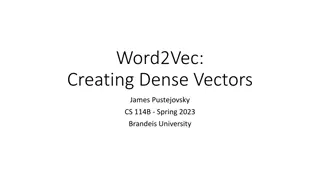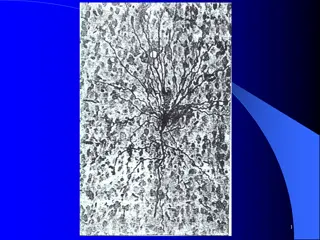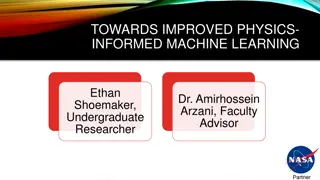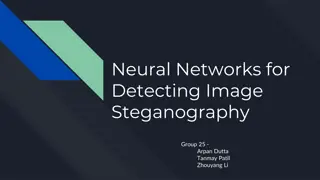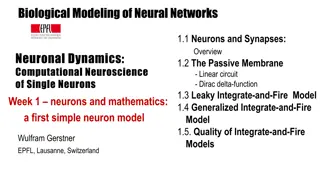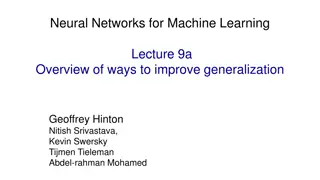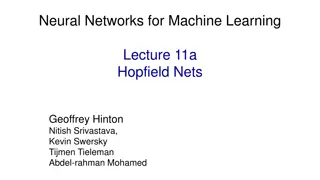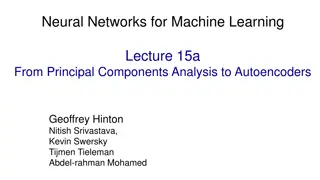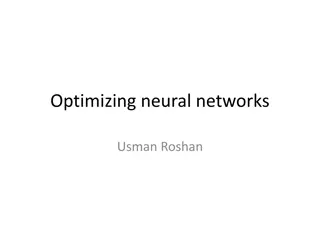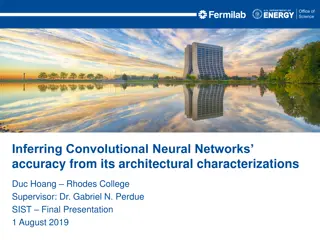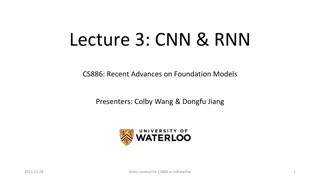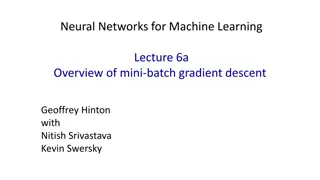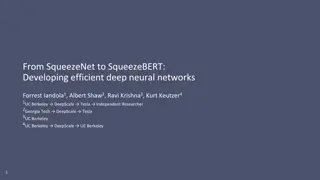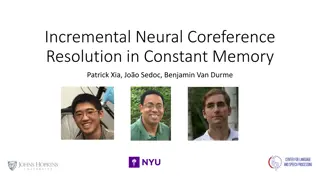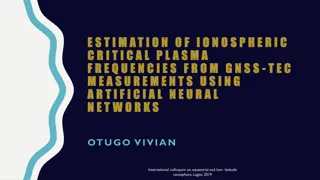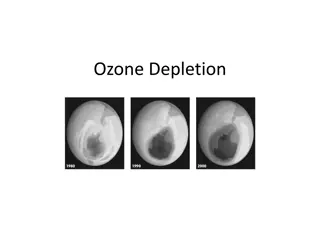Understanding Multi-Layer Perceptrons in Neural Networks
In this lecture by Dr. Erwin Sitompul at President University, the focus is on Multi-Layer Perceptrons (MLP) in neural networks, discussing their architecture, design considerations, advantages, learning algorithms, and training process. MLPs with hidden layers and sigmoid activation functions enable modeling of nonlinearity, with the Backpropagation algorithm used for training. Important MLP design considerations include activation functions, number of inputs, hidden layers, neurons per layer, and outputs. MLPs are powerful approximators and can be applied to dynamic systems with nonlinear relationships between input and output. The lecture emphasizes the importance of appropriate weight assignment and learning algorithms for efficient MLP performance.
Download Presentation

Please find below an Image/Link to download the presentation.
The content on the website is provided AS IS for your information and personal use only. It may not be sold, licensed, or shared on other websites without obtaining consent from the author. Download presentation by click this link. If you encounter any issues during the download, it is possible that the publisher has removed the file from their server.
E N D
Presentation Transcript
Introduction to Neural Networks and Fuzzy Logic Lecture 11 Dr.-Ing. Erwin Sitompul President University http://zitompul.wordpress.com 2 0 2 1 President University Erwin Sitompul NNFL 11/1
Neural Networks Multi Layer Perceptrons MLP Architecture Hidden layers Input layer Output layer x1 y1 x2 Outputs Inputs y2 x3 wlk wji wkj Possesses sigmoid activation functions in the neurons to enable modeling of nonlinearity. Contains one or more hidden layers . Trained using the Backpropagation algorithm. President University Erwin Sitompul NNFL 11/2
Neural Networks Multi Layer Perceptrons MLP Design Consideration What activation functions should be used? How many inputs does the network need? How many hidden layers does the network need? How many hidden neurons per hidden layer? How many outputs should the network have? There is no standard methodology to determine these values. Even there is some heuristic points, final values are determinate by a trial and error procedure. President University Erwin Sitompul NNFL 11/3
Neural Networks Multi Layer Perceptrons Advantages of MLP MLP with one hidden layer is a universal approximator. MLP can approximate any function within any preset accuracy The conditions: the weights and the biases are appropriately assigned through the use of adequate learning algorithm. x1 x2 x3 wlk wj wkj i MLP can be applied directly in identification and control of dynamic system with nonlinear relationship between input and output. MLP delivers the best compromise between number of parameters, structure complexity, and calculation cost. President University Erwin Sitompul NNFL 11/4
Neural Networks Multi Layer Perceptrons Learning Algorithm of MLP Function signal Error signal f(.) f(.) f(.) Computations at each neuron j: Neuron output, yj Vector of error gradient, E/ wji Forward propagation Backpropagation Learning Algorithm Backward propagation President University Erwin Sitompul NNFL 11/5
Neural Networks Multi Layer Perceptrons MLP Training k j i Right Left Forward Pass Fix wji(n) Compute yj(n) Backward Pass Calculate j(n) Update weights wji(n+1) k j i Right Left President University Erwin Sitompul NNFL 11/6
Neural Networks Multi Layer Perceptrons Learning Algorithm of MLP 0 1( ) y i ( ) = = w x , y f d Goal: k k 0 2( ) y i l ( ) ky i . . . 0( ) m y i Cost function / performance index: ( 1 2 i = ( ) E w ( ) kj kj w p 1 ) 2 = ( ) w ( ) ( ) E d i y i k k Minimize w E = w Weight Modification Rule President University Erwin Sitompul NNFL 11/7
Neural Networks Multi Layer Perceptrons Learning Algorithm of MLP 0 1( ) y i 0 2( ) y i l ( ) ky i . . . 0( ) m y i Backpropagation Learning Algorithm: Learning on output neuron Learning on hidden neurons President University Erwin Sitompul NNFL 11/8
Neural Networks Multi Layer Perceptrons Learning Algorithm of MLP ( ) Notations: = l k l k ( ) ( ) y i f net i 1 ly 1( ) . . . i m = 1 l k l kj l j ( ) ( ) i net i w y l ( ) ky i = 1 j 1( ) l jy i . . . the output of the k-the neuron of the l-th layer, at the i-th time instant l ( ) ky i 1( ) l m y i the output of the j-the neuron of the l 1-th layer, at the i-th time instant 1( ) l jy i President University Erwin Sitompul NNFL 11/9
Neural Networks Multi Layer Perceptrons Back Propagation Learning Algorithm Learning on output neuron ( ) = l k l k ( ) ( ) y i f net i 0 1( ) y i m = 1 l k l kj l j ( ) ( ) i net i w y 0 2( ) y i l ( ) ky i = 1 j . . . p 1 2 ( ) 2 = l k l k ( ) w 0( ) m y i ( ) ( ) E d i y i = 1 i l k l k p w w ( ) ( ) k ( ) ( ) l kj w ( ) ( ) k y i y i net i net i w E E = l l l kj ( net i net i ) f net i l k ( ) l k = ( ) ( ) k y i net i 1 i = l l k ( ) ( ) k ( ) ( ) = l f l k ( ) 1( ) l f net i l jy i ( ) ki Depends on the activation function President University Erwin Sitompul NNFL 11/10
Neural Networks Multi Layer Perceptrons Back Propagation Learning Algorithm Learning on hidden neuron i y i ( ) = 1 1 l j l j ( ) i ( ) i y f net 1( ) l jy 0 1( ) n = 1 1 2 l j l ji l i ( ) i ( ) i net w y 0 2( ) y i l ( ) ky i = 1 i . . . p 1 2 ( ) 2 = l k l k ( ) w 0( ) m y i ( ) ( ) E d i y i = net 1 i 1 l j ( ) i p w w ( ) l ji w ( ) l j E E = net 1 1 1 l ji ( ) i w = 1 i net 1 1 l j l j ( ) ( ) ( ) i y i p w w ( ) l ji w ( ) ( ) E E y = net 1 1 1 1 l j l j l ji i i w = 1 i President University Erwin Sitompul NNFL 11/11
Neural Networks Multi Layer Perceptrons Back Propagation Learning Algorithm 1 ( ) ( ) ( ) ( ) ( ) i ji j j w y i net i = net 1 l j l j ( ) i y i p w w E E = 1 1 1 1 l l l l ji w 1 net 1 1 l j l j ( ) ( ) ( ) i y i l k l k l j p w w ( ) ( ) k ( ) ( ) l ji w ( ) ( ) k y i y i net i net i y E E = net 1 1 1 1 l l l j l ji i w = 1 i 2( ) l iy i l ( ) ki ( ) ( ) 1( ) l k l j ( ) f net i f net i l kj w Depends on the activation function Depends on the activation function ( ) ( ) = = 1 1 l k l k l j l j ( ) ( ) ( ) i ( ) i y i f net i y f net m n = = 1 1 1 2 l k l kj l j l j l ji l i ( ) ( ) i ( ) i ( ) i net i w y net w y = = 1 1 j i President University Erwin Sitompul NNFL 11/12
Neural Networks Multi Layer Perceptrons Back Propagation Learning Algorithm Forward propagation ( ) = 1 1 l j l j ( ) i ( ) i y f net Set the weights Calculate output 1( ), j y i y i ( ) = l k l k ( ) ( ) y i f net i n = 1 1 2 l j l ji l i ( ) i ( ) i net w y m l l k = ( ) = 1 i 1 l k l kj l j ( ) ( ) i net i w x f(.) = 1 j f(.) Backward propagation Calculate error Calculate gradient vector E w p w ( ) l kj w ) w E ( ) f(.) = 1 l l k l j ( ) i ( ) ( ) i f net i y k = 1 i ( p w ( ) l ji w E ( ) l ( ) ki = 1 2 l l k l kj l j l i ( ) i ( ) ( ) i ( ) i f net i f net y k 1 = 1 i w w ( ) l kj ( ) l ji w E , 1 Update the weights President University Erwin Sitompul NNFL 11/13
Neural Networks Multi Layer Perceptrons Influential Factors in Learning Initial weights and bias Cost function / performance index Training data and generalization Network structure Number of layers Number of neurons Interconnections Learning Methods Weight modification rule Variable or fixed learning rate ( ) President University Erwin Sitompul NNFL 11/14
Neural Networks Multi Layer Perceptrons Homework 11 Write an m-file that will perform the backpropagation learning algorithm for the following neural network with 2 inputs, 1 hidden layer of 2 neurons, and 1 output layer of 1 neuron, no bias at all (all a = 1). Be sure to obtain decreasing errors. Note: Submit the hardcopy and softcopy of the m-file. = = = 0 1 0 2 2 1 y y 2 1 0 3 1 3 1 0 17 3 9 9 0 2 0 0 1( ) y i 2 1( ) y i d 0 2( ) y i Hint: The number of parameters to be trained is six. President University Erwin Sitompul NNFL 11/15
Neural Networks Multi Layer Perceptrons Homework 11A (Odd Student-ID) Write an m-file that will perform the backpropagation learning algorithm for the following neural network with 2 inputs, 1 hidden layer of 3 neurons, and 1 output layer of 1 neuron, with bias at all neurons (all a=1.2). Be sure to obtain decreasing errors (convergence). Note: Submit the hardcopy and softcopy of the m-file. = = = 0 1 0 2 2 1 y y 2 1 0 3 1 3 1 0 17 3 9 9 0 2 0 0 1( ) y i 2 1( ) y i d 0 2( ) y i Hint: The number of parameters to be trained is eleven. Deadline: See Google Classroom President University Erwin Sitompul NNFL 11/16
Neural Networks Multi Layer Perceptrons Homework 11B (Even Student-ID) Write an m-file that will perform the backpropagation learning algorithm for the following neural network with 2 inputs, 1 hidden layer of 3 neurons, and 1 output layer of 1 neuron, with bias at all neurons (all a=0.8). Be sure to obtain decreasing errors (convergence). Note: Submit the hardcopy and softcopy of the m-file. = = = 0 1 0 2 2 1 y y 2 1 0 3 1 3 1 0 17 3 9 9 0 2 0 0 1( ) y i 2 1( ) y i d 0 2( ) y i Hint: The number of parameters to be trained is twelve. Deadline: See Google Classroom President University Erwin Sitompul NNFL 11/17






